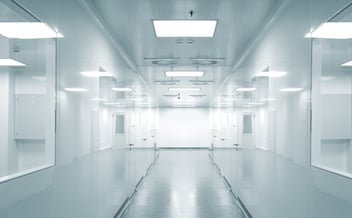So, we’ve discussed what the value of location awareness is in healthcare, as well as some of why locating things in hospitals is so tricky. In this post, we will start to dig into some of the techniques used for locating things in a healthcare setting and how they might be applied to locating a specific device indoors.
Many of these techniques should feel familiar from geometry class. These are learnings from the rich history of people getting lost on land, at sea, and, more recently, even off in space. Stars were really some of our original environmental beacons, and as a species we’ve iterated on the idea with our own constellation of GPS satellites. Given our previous discussions on unique challenges of indoors versus global location awareness, we’re going to need to get a bit more clever.
For the purpose of discussion, let’s assume that we’re trying to locate the position of a device, which is helped by environmental beacons that can send and receive signals. Don’t worry, we’ll get deeper into the tech in future articles, but let’s keep it simple for now.
A Few Ways to Figure Out Where a Thing is in a Hospital
Proximity
This is simplest of the simple. If we have some beacons and can tell which one the device is closest to… that tells us something, right? Accuracy in this case is entirely dependent on how many beacons you have and how reliably it can be determined which one is closest.
Distance here (and with future methods) is most often determined by how quickly some type of signal moves from one location to another. This is usually something in the radio spectrum, but some solutions use infrared, sound, or even visible light. Interference can be a big deal for distance calculations, since anything blocking or slowing that signal makes the beacon seem further away.
Pure proximity also gets impractical quickly, as effectively each known location would need its own beacon to determine distance. For one meter accuracy, you would need a beacon every single meter. Not the best for real world applications. But hey, it would be a very boring problem if the solution were this easy. So we’re going to need something a bit fancier.
Trilateration
Certainly the most popular for outdoor positioning, as it’s the big idea behind GPS. Effectively, if the device can determine its distance from three or more known beacons, there’s only one place in the world where all those distances could meet.
This means that for the area you need to cover, the device would only need to be able to see a few beacons to get a good fix. With sufficient signal strength, this requires far fewer beacons than proximity. Full global coverage of GPS, by example, is achieved with just 24 satellites. Granted, the outside of a sphere is a much friendlier shape for this geometry than the inside of any complex building.
Trilateration, like proximity, gets fuzzy when the distance can’t be reliably determined, so it is also vulnerable to interference. A better solution wouldn’t be solely reliant on that distance calculation.
Triangulation
Cousin to trilateration, but takes a different angle. Pun intended. I do not apologize.
Instead of distance, if the angle of arrival of a signal to the device can be determined from three or more beacons, the device’s position can be determined with high accuracy. Imagine vectors shooting out from each beacon’s known location. Where they cross will be that position we’re working so hard to determine.
This is less vulnerable to interference than distance measurements, since the power of the signal doesn’t matter, however the technology that supports this isn’t widely available. This doesn’t make it a great method for any solution involving readily available consumer technology, but we’ll dig into some promising future options in a later post. But for now we must keep searching.
Fingerprinting
Ok, now we’ve graduated middle school. Fingerprinting is not concerned with the location of any beacons as they relate to the device. Instead, it’s interested in the unique ‘fingerprint’ of signals the device can see at any given location within a facility. With a map of these signals, the device can determine its position in a language it understands.
There are a few prerequisites for this to be successful. It must be determined what signals to listen for, as this solution is highly vulnerable to noise. This signature needs to be consistent, while still complex enough that an individual location will be distinct enough to identify. Common signals used are bluetooth, WiFi, and, with some success, the Earth’s geomagnetic field.
Once the signal tapestry is either identified or created, it can be mapped, and overlayed over real world location data. When implemented correctly, this becomes an accurate and reliable method for the device to determine its own location.
Computer Vision
This one covers a fairly broad range of techniques, but the camera is a very powerful sensor which can tell us a lot about a location. For most of us, we search for visual cues to tell us where we are. Devices are able to simulate this in important ways. If landmarks can be recognized, or important physical criteria such as depth or distance from the walls or floor can be measured, these can be compared against what the device knows about the location with slick tools like 3D mapping.
This requires a good bit of horsepower, however, both in camera use and in the processing necessary to make the footage useful. Many buildings have unremarkable interiors, without landmarks or heavy visual distinction from one hallway to the next. Common situations, like a crowded room, can also make gathering that visual data difficult. In some cases, like in hospitals where privacy is paramount, it’s not an appropriate environment to be walking around with your cameras on, even if it’s not recording.
That said, computer vision can add a greater level of accuracy to other methods, and would be fundamental to future technology such as augmented reality solutions. It’s definitely an area for future development, but has some hurdles to jump first.
Dead Reckoning
This is our last method worthy of mention, which again dates back to nautical navigation. Ships that diligently kept track of their orientation and velocity could track their course over time. This became absolutely critical to crossing the open seas with no available landmarks to gauge how far they’ve traveled on their journey. These methods, however, remain highly subjective to cumulative errors and drift. If even one update is fudged, all following calculations will be offset.
The modern equivalent can leverage all kinds of sensors and doodads for the device to track its progress over time. Gyroscopes, accelerometers, magnetometers, and other, now common, tools can tell a great story about how the device is moving through a facility. The reliability of technology over human error also helps limit the fudge factor, reducing drift over time.
This is, of course, is also only useful if the device’s initial location is known. Dead reckoning is best combined with one of the previous methods of determining the device’s location, and in doing so becomes a valuable way to augment and vet them. It can connect positional intelligence with an understanding of how the device can move through space. The device is as unlikely to teleport as it is to pass through a wall. Tracking how it moves can help connect the dots, instead of just calculating disparate positions over time.
Wrapping It Up
Most solutions you’ll find out in the wild making use of indoor location to varied effect will be implementing one flavor or another of the techniques discussed here. Or, in most successful cases, they’ll be using a combination of several methods. Depending on what’s being attempted, different strengths and weaknesses can be mitigated or made irrelevant. Next time, we’ll dig deeper into some of the technologies being used and how they’re being leveraged to help people figure out where things are.


